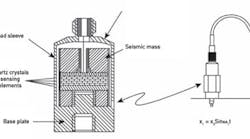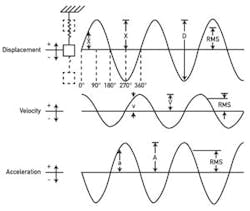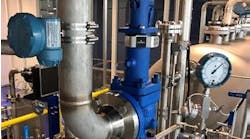This column is moderated by Béla Lipták (http://belaliptakpe.com/), automation and safety consultant, who is also the editor of the Instrument and Automation Engineers' Handbook (IAEH). If you would like to become a contributing author of the 5th edition or if you have an automation related question for this column, write to [email protected]
Q: I am an instrumentation design engineer in the oil and gas industry, and I have a question about valve noise and vibration. I know that on liquid service, cavitation and flashing can cause vibration. What about gas service? What would cause vibration, and what protection can we apply if it occurs?
M. Ulaganathan
[email protected]
A: Flashing and cavitation does not occur in gases, but vibration, caused by choked flow, can develop as the gas reaches sonic velocity. This velocity is usually reached when the valve pressure drop rises to 50% of the upstream pressure. Vibration of long pipelines can also occur due to mechanical damage, any type of shock, earthquakes, etc., and monitoring it is necessary in order to trigger safety interlocks if it gets excessive.
Vibration can be monitored by detecting the displacement it causes, the velocity (rate time) by which displacement occurs, or by accelerometers, which detect the rate at which this velocity changes. If the oscillation caused by vibration is detected by velocity, that oscillation has a phase shift relative to that of displacement, and acceleration has a phase shift relative to velocity (Figure 1).
Figure 1: The phase shifts between the vibration cause oscillation in displacement (D), in velocity (V) and in acceleration (A).
The operating principles of the sensors can be: 1) seismic (inertial), 2) piezoelectric, 3) piezoresistive and strain gauges, 4) electromechanical, 5) capacitive and electrostatic, 6) micro- and nano-sensors, 7) velocity, 8) noncontact proximity, 9) mechanical switches or 10) optical. The most common are the piezoelectric sensors (Figure 2), which in remote locations such as oil or gas pipelines, can be provided with wireless transmission.
The longer and larger a natural gas pipeline is, the more damage vibration can cause to it. As more and more long pipelines are built, the more important vibration detectors will become for purposes of detecting their integrity for both safety and security.
Bela Liptak
[email protected]
A: In gas service, you need to worry about the pressure drop. When you drop the pressure down by 50% or more (for most gases), the valve will likely be choked, and accompanied by the presence of a very thin invisible layer immediately downstream of the valve exit—known as shock waves. If you have safety valves upstream of the valves, they may pop, since the valve can't pass more flow than the critical mass flow rate at the critical pressure ratio, and be accompanied by shock waves and loud noise. The piping will vibrate.
If you have a pipe elbow downstream of the valve, e.g. at 10D, the vibration problem can be more severe. In this case, the whole piping and valve assembly can swing with amplitudes that could be visible to naked eye. Do not open the valve quickly. Sometimes it may be required to open the valve 10% in 10 minutes to be safe. Check piping vibrations and the mechanical integrity of the valve anchor. Under no circumstances should valve stem or bonnet vibrations exceed 0.5 inches per second rms total, which is the dangerous limit. Should vibrations be continuous in normal operations and exceed 0.1 inches per second rms total at all times, check the linkage of the positioner no less than once every three months. The valve should be
replaced under forced shutdown if automatic control of the valve fails due to breaking of the positioner linkage (owing to vibrations).
Figure 2. The main components of a piezoelectric detector are the body, the sensing element and the seismic mass.
The worst damage internal to the valve and to the internal piping can occur downstream. It's caused by condensation moving at the speed of the gas during start-up. Such condensation can erode the valve seat quickly and attack the downstream in-line silencer by breaking it into pieces. If you have rotary equipment, such as turbines etc., downstream of the valve, then the cost of the damage can escalate.Please note that nowadays, in-line silencers (path treatment of noise) can be replaced by source treatment types. The problem of condensation can be partially treated by installation of a bypass line for the valve to prevent the valve internal from being damaged, but this way the problem can be passed on to downstream equipment. Therefore, operation procedure should be reviewed or updated to make sure that such condensation is drained before opening the valve during start-up.
Gerald Liu
[email protected]
A: Control valves may be used in gas service without concern for flashing and cavitation effects, since these effects only occur in liquid flow. Flashing is the condition in which a liquid passing through a control valve encounters a pressure drop to a lower pressure at which the flowing liquid boils. The act of boiling is the phase change from the liquid state to the vapor state, and is characterized by the rapid expansion of gas bubbles.
We observe this state change occurring exactly at the most narrow point of the flow path, at the seat of the control valve, as a noise that we call cavitation. The effect of cavitation is to erode the valve plug and valve seat, actually removing metal by a combination of the physical forces of boiling and the sonic energy some of which may be in the ultrasonic range.
Control valves are not subject to flashing when controlling the flow of gases and vapors. To control the flow of liquids at temperatures close to their boiling point, it is recommended to modulate the flow by using variable-frequency drives on the centrifugal pumps, and thereby eliminate the use of control valves completely.
Richard H. Caro
[email protected]
A: Control valves in gas service have their own list of issues to consider. Some of the major issues are:
- Choking. When the gas velocities within the valve approach sonic velocity, then standing sonic waves form that limit the total flow through the valve. Further reduction of the downstream pressure will yield no increased flow through the valve. (A complete explanation of this particular condition is a lot more involved, but you understand the general idea.)
- Noise. When the pressure drop and gas velocities through the valve are very high, the valve will generate a great deal of noise. This is obviously a concern for personnel hearing exposure, but it can also damage the valve internals if the noise level is high enough. (The noise can literally vibrate the valve apart.)
- Wire drawing. If a valve is operated in a barely opened position in steam service for any length of time, the steam tends to cut the seat, and result in increasing leak rates and damaged internals.
I'm sure there are other issues as well but these are the more common ones.
Hunter Vegas
[email protected]







